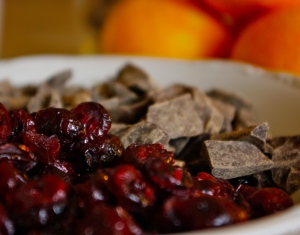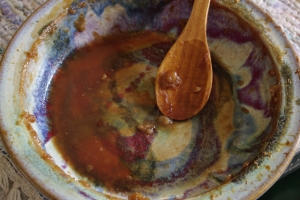Arctic air mass.
I like the words “arctic air mass.”
Of course, I don’t actually like the arctic air mass itself, and one is moving in rather rapidly.
Cold is one thing, frigid is something else altogether.
That, by the way, is not a complaint. I am not allowed to complain about the cold because I complain constantly about the heat all summer. I figure I can want it one way or the other, but I can’t want it both. I choose cold weather over hot weather every time.
I haven’t started watching the second season of Downton Abbey yet. Last spring, one day when I was feeling ill, I found the first season of Downton Abbey available for streaming on PBS.org. I made a batch of apricot scones and a large pot of tea, and sat down to watch all four episodes in one go. I couldn’t have stopped watching if I tried, but I had no desire to try. I devoured the program and I felt ever so much better when it was over. So this time, I know to wait for all the episodes to be available before I begin; I can wait a few more weeks to see the second season, but I couldn’t wait a week in between episodes. I don’t have that much stamina.
The New York Times published a feature on the books that people are reading while they await their next Downton fix. One of the books on the publishers’ list of recommendations is Love in a Cold Climate by Nancy Mitford. I have been looking for a suitable used copy of the book for quite some time but haven’t found one locally yet. The DVD of the televised version of it, however, made it to the top of my Netflix queue, so I have that to watch this weekend. It seems wildly appropriate for the atmospheric conditions.
I just put three loaves of lovely beige whole-wheat bread in the oven. I designed it specifically to be particularly receptive to peanut butter, composing it primarily from white whole-wheat flour, brown sugar, and milk. And I bought a fresh jar of Teddy peanut butter too. Tomorrow I am going to have a really good peanut-butter sandwich.
Tonight though, I’m going to watch my movie after I take the bread out of the oven. In the meanwhile, here is a little something that will make the approaching arctic air mass a little easier to live with: chocolate bread pudding.
Bread pudding is one of those things that is fabulous no matter what you put in it, and it is great for using up those little bits of leftover things that need to be used before they spoil. You can put in whatever you have on hand. Apples and raisins are traditional (and delicious), but sometimes I like to mix it up a bit and put in spinach and mushroom and cheddar cheese instead. You really can’t go wrong if you keep your sweet and your savory a respectable distance apart (meaning don’t put cinnamon and spinach in together).
I like to use cranberry-walnut sandwich bread when I make chicken sandwiches. I made some in the fall, intending to write a post about it, but time got away from me as it so often does, and I stuck half a loaf in the freezer so I could do it “later.” Then I bought several bags of cranberries when they were on sale and stuck those in the freezer too, apparently on top of the bread. I spent the next several weeks thinking that whole pile in the back of the freezer was cranberries, but to my great surprise, this week when I took out some cranberries to make cranberry sauce, I found that half loaf of bread. It cried to be made into bread pudding. How could I resist?
Before Christmas, I bought two bags of oranges and some pink grapefruit. Then I was given some red navel oranges. Then I bought some clementines. Then this week I bought some Moro oranges and some white grapefruit. In between, we had (literally) a bushel of apples. Needless to say, some of those first oranges (having rested in the refrigerator all this time) are reaching the end of their allotted time on earth. And because oranges have such an affinity for chocolate, I thought a little orange zest in the custard would be quite welcome.
And let’s face it: it’s not chocolate bread pudding without chocolate. I have seen recipes that call for the chocolate to be melted into the milk so that the whole of the custard becomes chocolate, but I like to have chunks of melted dark chocolate in my pudding, so I leave the chunks quite large. And since the bread had cranberries in it, I thought the pudding could only benefit from the addition of more dried cranberries (also delicious with chocolate).
In a great confluence, I also had extra milk and eggs (a rare thing to be sure).
So as not to impede the spontaneity of the pudding, it is best not to give exact measurements. The idea is to use up stock on hand, so whatever you have is what you will make. My half loaf of bread filled my medium sized souffle dish perfectly, so that is how much pudding I made. Sometimes I have far more bread collected in the freezer, and I fill a much larger baking dish. Use what you have.
As for the milk-to-egg ratio, it is quite flexible. Generally speaking, I use one egg to one cup of milk, but if you have only 3 eggs and need 4 cups of milk to cover the bread and assorted bits in your dish, then it won’t suffer. The same applies if you have a few leftover egg yolks.
Sugar is added to taste. For a quart of milk with four eggs, I might put in half a cup of sugar, or maybe a little more if I am not using chocolate. (Use no sugar at all for a savory pudding, but do use half a teaspoon of salt and some pepper and herbs to complement the greens, cheese, and other vegetables.) The sugar can be white or brown, depending on your intentions. Both are good, but the brown sugar will provide a more pronounced flavor. This can be desirable depending on what else you are putting in. This time, knowing I already had chocolate, orange, and cranberries, I used white sugar so as not to add a competing flavor.
That said, do add a little vanilla, or better still, vanilla brandy. I put in a couple generous tablespoons of vanilla brandy, and I could have added a little more still without it being too much. Vanilla brandy loves bread pudding as much as I do.
In preparing the bread this time, I was in a rush, so I cubed it. That was a mistake. I should have take the time to tear it as I usually do. The torn edges of the bread will readily coalesce with one another, making a solid, sliceable pudding when it is cold. When the bread is cubed with perfectly straight edges, they cubes stay as cubes, and the texture of the pudding is adversely affected. Next time I promise to take more time and cut slices and then tear them into bite-sized pieces.
Butter your baking dish well. Toss together the torn bread, chocolate, and cranberries. Lightly beat the eggs into the milk. (Whole milk will make a richer, more delectable pudding, but use any milk you have, particularly if it a choice between using almost-sour milk today and pouring spoiled milk down the sink tomorrow.) Stir in the sugar and then add the vanilla or vanilla brandy to the milk mixture. Stir in the finely grated orange zest and grate a little fresh nutmeg into it too, if you have a nutmeg hanging around. It ties the whole thing together.
Pour this milk mixture over the bread, making sure all the bread is covered (add a little more milk if you misjudged it; it is okay to just pour it over the top until you have as much as you need) and allow the bread to soak up the custard for a half hour or more. It is not necessary to refrigerate the mixture during this time. If you are preparing it a day ahead, however, it should be refrigerated, but if you are baking it in the very near future, it is fine at room temperature.
Preheat the oven to 325°F. My mother always used to bake bread puddings in a water bath, but I had trouble finding the right sized pans to do this with, particularly when I was making a lasagna pan full of bread pudding, so I gave it up. You can if you want to and know you have suitable pans to do it. Otherwise, it will come out quite nicely just baked by itself on the oven rack.
The length of time you bake it will naturally depend on how large your dish is and how many eggs you put in the custard. You want the crust to be deep golden brown and the center to be set. If the top looks done, but the center is just a little runny still, it is usually okay to take it out of the oven and let it cool; the center will firm-up as it cools.
This is a wonderful addition to any brunch, or as a breakfast on its own, or a warming snack. It might be a little heavy for dessert, unless you have a very light meal, such a vegetable soup. But any way you eat it, it will bring warmth and enjoyment into your day.









































